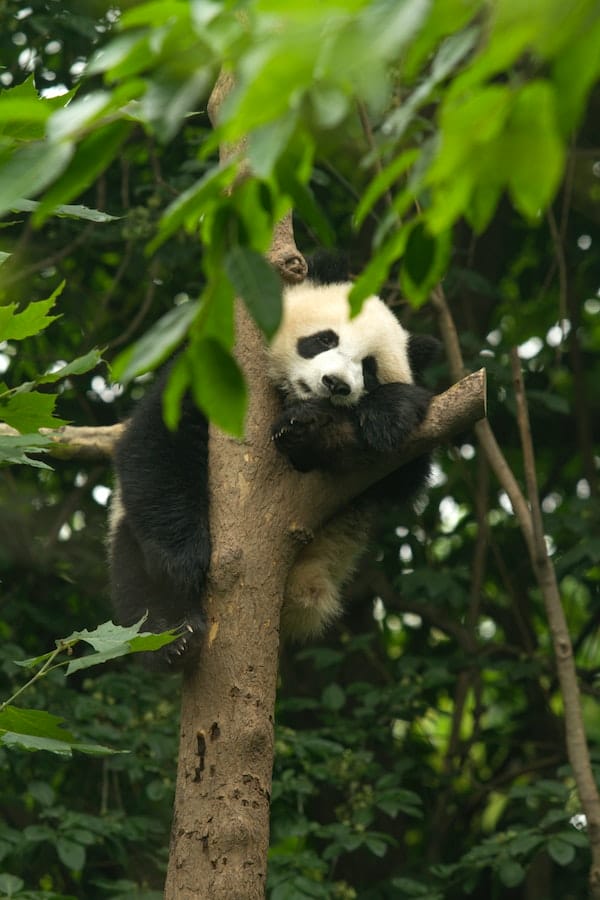
Pandas are one of the most fascinating and charismatic animals in the animal kingdom.
With their distinctive black-and-white markings and adorable faces, they are beloved around the world for their cuteness and endangered status.
There is a lot that you may not know about these amazing creatures, so here are some interesting panda facts to get you started.
Fact #1: The scientific name for the panda is Ailuropoda melanoleuca.
The scientific name for pandas, Ailuropoda melanoleuca, literally translates to “black and white cat-foot.”
This name is a fitting description of these adorable creatures, with their distinctive black and white markings and cuddly faces.
Fact #2: Pandas are native to China.
Pandas are native to China and can be found in the mountains of Sichuan, Shaanxi, and Gansu provinces.
These majestic creatures make their home in some of the most rugged and remote regions of China, living high up in the cold, misty mountain forests.
Despite their wide range across these three provinces, pandas are increasingly threatened by human activities, including habitat loss and poaching.
Fact #3: There are two types of pandas – the giant panda and the red panda.

Pandas come in two distinct varieties – the giant panda and the red panda.
The giant panda is much larger than the red panda, with thick black fur covering its ears, eye patches, muzzle, legs, and shoulders.
The smaller red panda has reddish-brown fur and a bushy tail.
Despite their differences in size and appearance, both types of pandas share many of the same characteristics, including their adorable faces, distinctive black-and-white markings, and threatened status in the wild.
Fact #4: Pandas are classified as bears but they have a diet that consists mostly of bamboo.
Pandas are classified as bears, but their diet is quite different from other bear species.
Rather than relying on meat for sustenance, pandas primarily eat bamboo – up to 12kg (26 lbs) of it each day!
Because of this specialized diet, pandas have adapted many unique features that help them survive in the wild.
Fact #5: Pandas have a very slow metabolism.
Pandas are unique animals with a prolonged metabolism that allows them to spend up to 16 hours each day eating bamboo.
This specialized diet requires them to have adaptations like strong jaws and flat molars that help them efficiently process the tough, fibrous stalks of bamboo.
Fact #6: Pandas have an excellent sense of smell but poor eyesight.
Pandas have many unique adaptations that help them survive in the wild, including an excellent sense of smell but poor eyesight.
With their large noses and prominent ears, pandas can pick up on even the faintest scents in their environment, allowing them to detect prey and potential mates from great distances.
However, because they rely on their sense of smell so heavily, pandas have poor eyesight, making it difficult for them to see predators or other obstacles in their path.
- Read also: How to Name a Panda
- Read also: Famous Panda Names
Fact #7: Pandas are generally solitary animals.

Pandas are solitary animals, spending most of their time alone in the forests of China.
However, during mating season or when there is a plentiful food source available, they will come together to form groups with other pandas.
This helps them find potential mates and share information about food sources in their environment.
Though they are generally solitary creatures, pandas are highly social animals that rely on each other to survive and thrive in the wild.
Fact #8: Female pandas give birth to one or two cubs at a time.
Female pandas give birth to one or two cubs at a time, but only about 50% of these cubs survive to adulthood.
This is due to factors such as predation and a lack of food availability in the wild.
Fact #9: Cubs are born blind and weigh only about 150g (5oz).
Cubs are born blind and very small, typically weighing only about 150g (5oz).
They remain dependent on their mother’s milk for the first 6-8 months of life, gradually weaning off of it as they begin to eat solid foods.
During this time, they develop the strength and coordination needed to survive in the wild on their own.
Fact #10: Pandas reach sexual maturity at around 4-5 years old.

Pandas reach sexual maturity at around 4-5 years old, but they do not generally start breeding until they are 6-7 years old.
This is due to several factors, including the high energetic costs of pregnancy and raising young, as well as a lack of suitable breeding habitats in the wild.
Nevertheless, once pandas reach reproductive age, they are able to produce offspring that have the same chance of survival as any other animal in the wild.
Fact #11: The life expectancy of a wild panda is around 20 years.
Pandas are known for their long lifespan – in the wild, they can live up to 20 years on average, while pandas living in captivity have been known to live for as long as 30 years.
This is due to various factors, including low levels of stress and fewer risks of predation and injury in captivity.
Overall, pandas are fascinating animals with many unique adaptations that allow them to survive and thrive in the wild.
Whether they survive on a specialized bamboo diet, using their keen sense of smell to detect prey, or producing one or two cubs at a time, these amazing creatures have much to teach us about the natural world and our place within it.
So the next time you see a panda in the wild or at your local zoo, take a moment to appreciate all that they have overcome and all that they continue to teach us about ourselves and our world.


GIPHY App Key not set. Please check settings